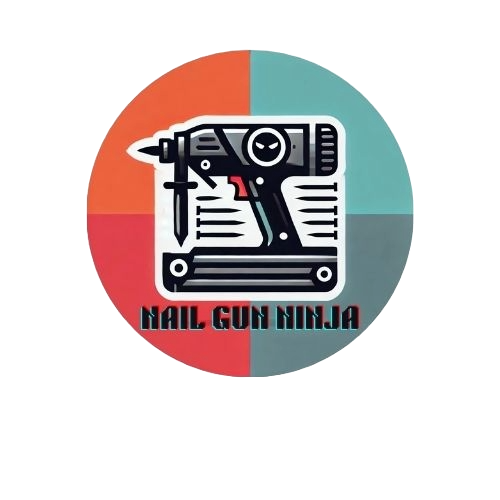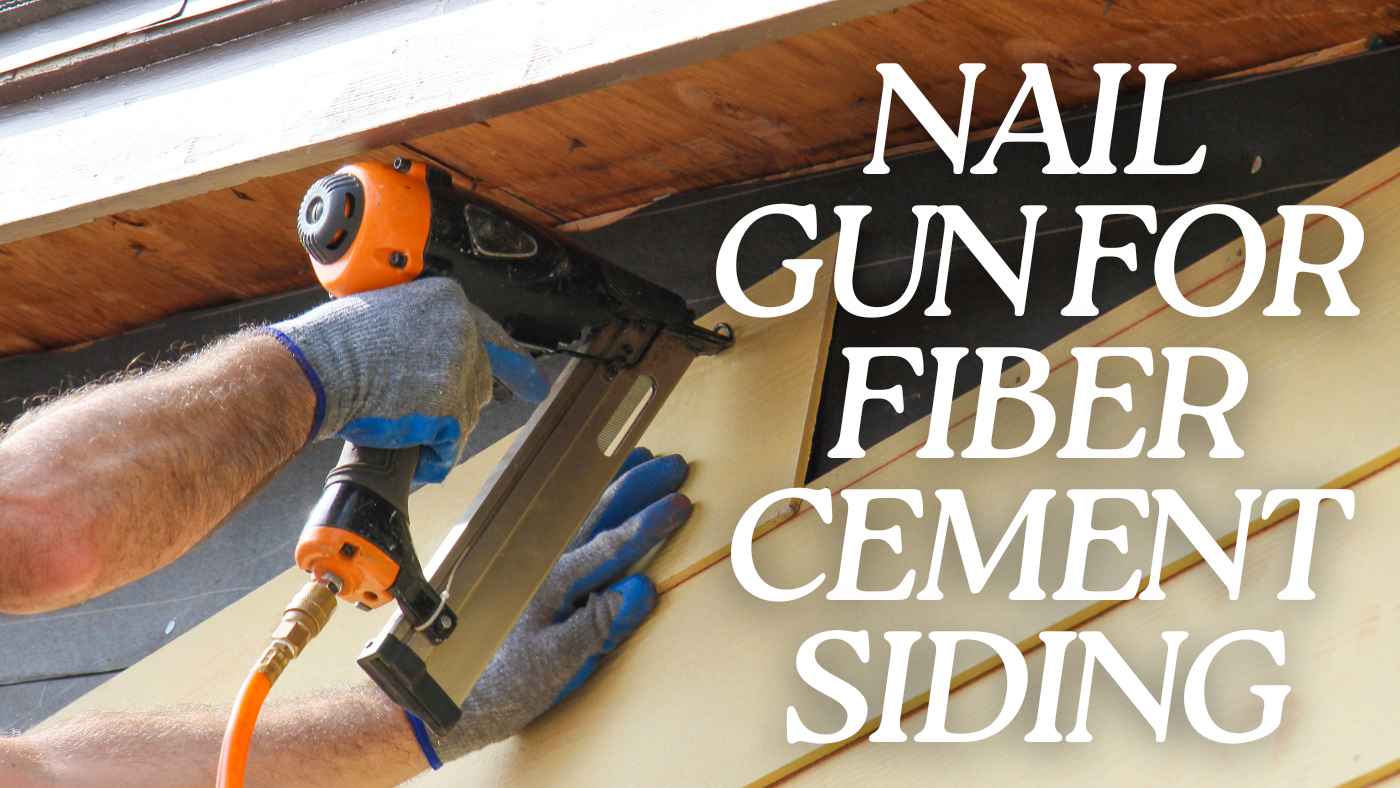Fiber cement siding is also known as fiber cement cladding or hardie plank. In different countries, it is known by different names. It is a building material used to cover the exterior of residential or commercial buildings.
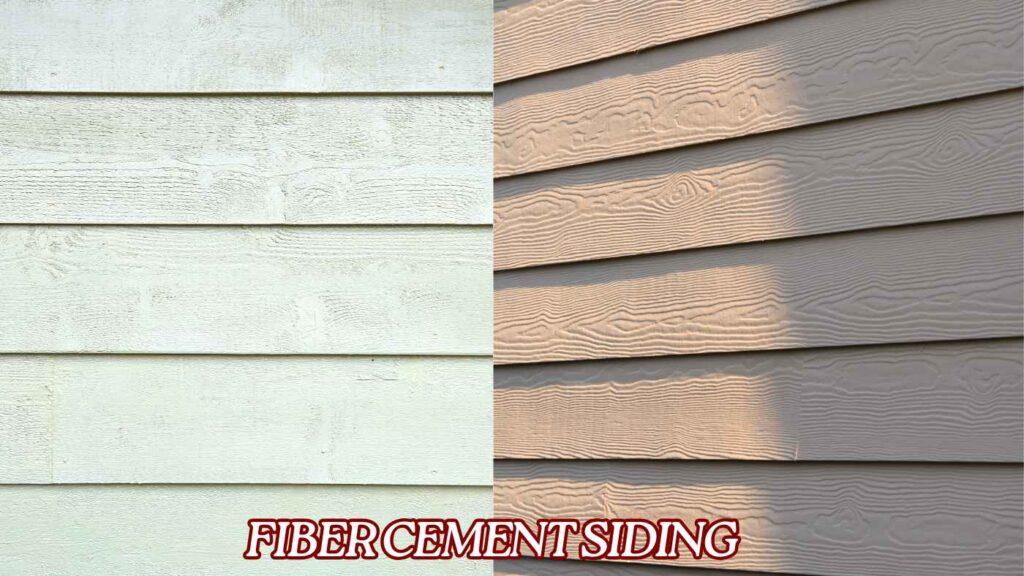
To install fiber cement siding, we need different tools like, screw guns, drills, screws, nails, nail guns, etc. A nail gun for fiber cement siding is very effective in installing them perfectly.
Coil siding or siding nailers are the best options and are designed for siding related projects. Therefore, if you plan to install fiber cement siding then you can use siding nailers or 15 degree coil siding nailers as long as they meet the specific requirements.
Why Choosing the Right Nail Gun Matters for Fiber Cement Siding?
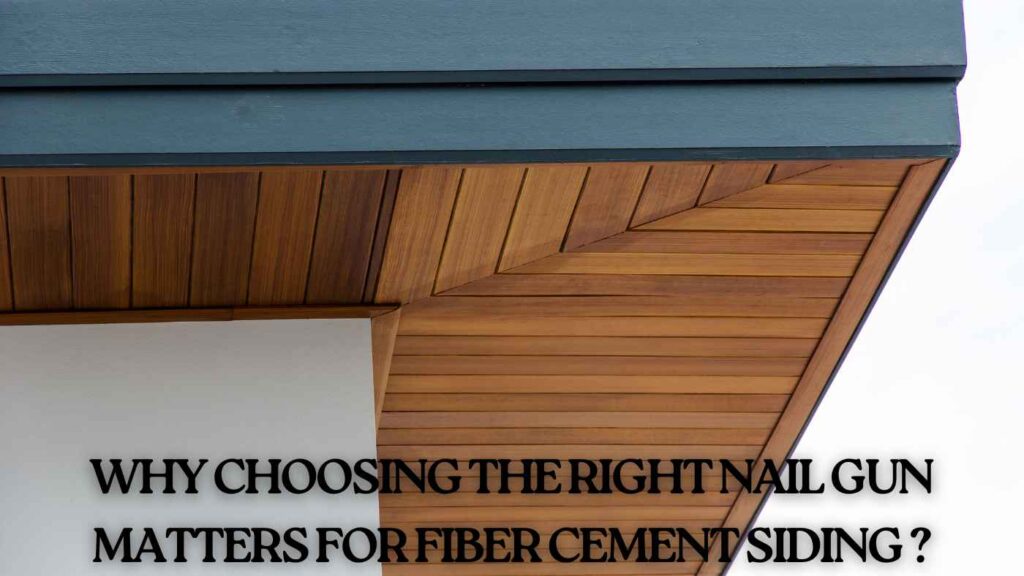
Fiber cement siding is a strong and versatile material. Its dense structure makes proper fastening very important for a long lasting installation.
Choosing the right nail gun is key to meeting the specific needs of this material and ensuring a successful project.
Ensuring a Durable Installation
Fiber cement boards need nails that go in deep and hold securely without causing any damage.
Using the wrong nail gun can lead to weak fastening. It may affect the structure’s stability and reduce its durability.
Preventing Cracks and Breakage
Due to its dense makeup, fiber cement can crack or break if the wrong tools or techniques are used.
Nail guns with low pressure or frequent misfires can damage the boards. It will result in wasted material and expensive repairs.
Achieving Efficiency & Accuracy
A nail gun designed specifically for fiber cement siding can place nails evenly and consistently. This not only strengthens the siding but also gives it a professional look.
Features like adjustable depth settings and the ability to use corrosion resistant nails are essential for the best results.
Types of Nail Guns Suitable for Fiber Cement Siding
We know, a nail gun is powerful enough to drive nails into fiber cement siding. But we need to pick the right tool to apply nail gun power and efficiency for professional results.
Here are the best types of nail guns for fiber cement siding with their features, benefits, and tips:
Pneumatic Nail Guns
Pneumatic nail guns are the go to choice for heavy duty jobs like installing fiber cement siding.
These tools use compressed air to provide the power needed to handle dense materials.
Features & Benefits
- High Power: Pneumatic nailers deliver consistent force that makes sure nails are driven deep without splitting the siding.
- Reliable Performance: These nail guns are built to last and perform well during large projects.
- Versatile: They are enough versatile to use different nail sizes. It makes them useful for more than just siding.
Tips for Use
- Connect the nail gun with the right size air compressor for smooth performance.
- Always use stainless steel or galvanized nails to prevent rust on the siding.
- Adjust the depth setting to ensure nails are driven correctly without overdriving or underdriving.
Coil Siding Nailers
Coil siding nailers are specifically made for siding projects. They are one of the best options for installing fiber cement siding.
These nailers are designed to handle the specific nails and materials used in siding installations.
Features & Benefits
- Large Nail Capacity: The coiled magazine can hold a lot of nails. So you don’t need to reload the nail magazine frequently.
- Optimized for Siding: Designed to work with corrosion resistant nails like stainless steel or hot dipped galvanized nails. These nails are perfect for outdoor use.
- Lightweight Design: Many models are lightweight and easier to use for long periods.
Tips for Use
- Try to use the models or brands with adjustable depth settings for accurate nail placement.
- Choose nailers that can use nails between 1-1/4 inches and 2-1/2 inches. This length of nails works well for fiber cement siding.
- Clean the nailer gun regularly after use to prevent jamming. Especially when working in dusty areas.
Framing Nailers
Though framing nailers are usually designed for structural work, some models can also be used for fiber cement siding.
Make sure the nailer meets the requirements for this type of job. You have to consider some important things while applying this nailer gun for fiber cement.
Features & Benefits
- Versatile Tool: Ideal for professionals who need a tool that can handle both framing and siding tasks.
- Powerful Performance: Strong enough to drive nails into fiber cement siding without trouble.
- Adjustable Depth Settings: Many models let you control how deep the nails will be penetrated for precise results.
Things to Consider
- First, check if the framing nailer is compatible with siding nails. If it is, then you can use this nailer.
- Use a nailer with a no mar tip safety feature to avoid scratching or denting the siding.
- Keep in mind that, framing nailers may be bulkier and less specialized than 15 degree coil siding nail guns.
Gas Powered Nail Guns
Gas powered nail guns are a cordless option for installing fiber cement siding. They’re great for job sites where compressed air isn’t available. Furthermore, it is more movable than pneumatic ones.
Features & Benefits
- Cordless Convenience: No hoses or air compressors are needed. It will give you more freedom to move around.
- Strong Performance: These nailers deliver enough power to work with dense materials like fiber cement.
- Versatile Use: They can be used for other construction tasks. You can use them as a useful addition to your toolkit.
Drawbacks to Keep in Mind
While you are using a gas nail gun for fiber cement siding, then you have to consider some limitations.
- Gas powered nail guns come with gas cartridges. Gas cartridges often increase your project cost.
- These nail guns also need proper maintenance, which might enhance your cost.
- These power nailers are usually heavier than pneumatic models. So, it can cause hand fatigue issues during longer jobs.
What Size Nail for Fiber Cement Siding?
When installing fiber cement siding, choosing the right nail size is crucial for a strong and secure installation.
Using nails that are too short or unsuitable can lead to loose siding, poor durability, or even water damage.
Here’s a simple guide to help you understand the correct nail size for this siding project:
Recommended Nail Sizes for Fiber Cement Siding
Length
- Nails should be long enough to penetrate at least 1 to 1 1/4 inches deep into the framing studs or the solid sheathing under the siding.
- Generally, nail lengths range from 1 1/2 to 2 1/2 inches. The exact size depends on the thickness of the siding and any added layers like sheathing or insulation.
Gauge (Thickness)
- Choose nails that are 11 to 13 gauge.
- These sizes are strong enough to handle the dense material without bending.
Head Type
- Use flat or small diameter heads.
- These head types will secure the siding well without causing damage.
- For blind nailing small heads work best.
Type of Nail
- Hot dipped galvanized or stainless steel nails are a must.
- They resist rust and staining in humid or coastal areas.
Nailing Methods & Placement
Blind Nailing
- Nails are driven into the top edge of the siding, which will be covered by the next piece.
- Place nails 3/4 to 1 inch from the top edge of the siding.
- Space the nails 16 to 24 inches apart. Try to ensure that they are aligned with the studs.
Face Nailing
- Nails are driven through the front surface of the siding and remain visible.
- This method is often used in strong winds prone areas.
- Position nails 3/4 inch from the edges to ensure they are flush with the siding surface.
- Avoid overdriving the nails.
Common Nail Length Based on Siding Thickness
| Siding Thickness | Nail Length (Recommended) |
| 5/16 inch | 1 3/4 to 2 inches |
| 7/16 inch | 2 to 2 1/4 inches |
| 1/2 inch | 2 1/4 to 2 1/2 inches |
Key Features to Look for in a Nail Gun for Fiber Cement Siding
There is no all in one featured nail gun for fiber cement siding projects. Not all nail guns are the same.
As a result, choosing the right featured nail gun is a crucial part of this project. You need to find out some features in your nail gun that will be perfect for fiber cement siding.
Here is the list of key features to consider:
Adjustable Depth Settings
The nail depth needs to be just right to avoid splitting the siding or leaving nails underdriven. A nail gun with depth adjustment features helps you:
- Prevent Overdriving: Avoid driving nails too deep which can weaken the siding.
- Achieve Flush Nails: Ensure nails sit level with the surface for a clean and secure finish.
High Power & Durability
Fiber cement siding is dense and tougher than wood to work with. Your nail gun should be:
- Pneumatic or Gas Powered: These options can deliver the strength to drive nails into the material.
- Sturdy and Reliable: Choose a tool with a durable build quality to handle heavy duty work.
Large Nail Magazine Capacity
For larger projects like siding, frequent nail reloading can slow down your work performance.
- Coil Siding Nailers: These models store a lot of nails in a coil. They reduce nail reloading time.
- Quick Reload Features: Tools with easy reloading systems save both time and effort.
No Mar Tips
Protecting the surface of the fiber cement siding is important for looks and longevity. A no mar tip feature ensures:
- Scratch and Scuff Protection: Keeps the siding’s finish smooth and clean.
- Prevention of Dents: Avoids accidental damage during fiber cement installation.
Lightweight & Ergonomic Design
Installing siding involves repetitive work and long hours. Assure a well designed nail gun with a lightweight and ergonomic design.
- Reduces Fatigue: A lightweight nail gun reduces strain on your arms and shoulders.
- Improves Comfort: Makes it easier to work in tight spaces or elevated areas.
Exhaust Control
Fiber cement siding creates dust during cutting and nailing. A tool with exhaust control helps you:
- Redirects Air Away: Keeps dust and debris from blowing towards you.
- Keeps the Workspace Clean: Improves visibility and minimizes cleanup time.
Trigger Options
Different trigger types can enhance safety and efficiency:
- Sequential Trigger: Lowers the risk of accidental firing. It is safer to use.
- Contact Trigger: Speeds up repetitive tasks but needs to be handled carefully to avoid misfires.
Noise & Vibration Reduction
Extended use of a nail gun can cause hand fatigue and affect precision. Long time noise can affect your hearing.
- Improve Comfort: Make it easier to handle the gun for long periods.
- Enhance Accuracy: Steadier handling results in more precise nail placement.
- Less Noise: Try to use a nail gun with noise reducing features to make the work more comfortable and less disturbing.
Safety Features
Safety is critical when working with power tools. Choose a nail gun with enough safety features.
- Anti Dry Fire Mechanism: Prevents firing when the magazine is empty to reduce damage and misfires.
- Ergonomic Grip: Ensures a secure and comfortable hold to minimize the risk of hand slipping.
- Tool Free Jam Clearing: This makes it easy to remove jammed nails. It will save you time.
- Safety Gears: Put on the required safety gear before starting your work.
Top 5 Nail Guns for Fiber Cement Siding in 2025
Here is a list of the top 5 nail guns in 2025:
1. Metabo HPT NV65AH2 Coil Siding Nailer
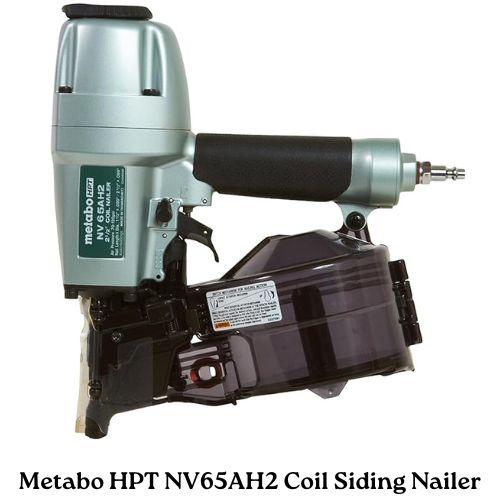
Key Features
- Drives nails from 1-1/2 to 2-1/2 inches with 16 degree wire collated coil siding nails.
- Lightweight aluminum body, only 4.8 lbs (approx.)
- Switch between sequential or contact nailing triggers.
- Easy depth adjustment setting for precise nail placement.
- Tilt the bottom magazine, and side load for easy reloads.
Why You Should Choose It
This Metabo HPT NV65AH2 nail gun is a top choice among professionals because of its reliability and accuracy. It works seamlessly with galvanized and stainless steel nails.
2. Bostitch N66C-1 Coil Siding Nailer
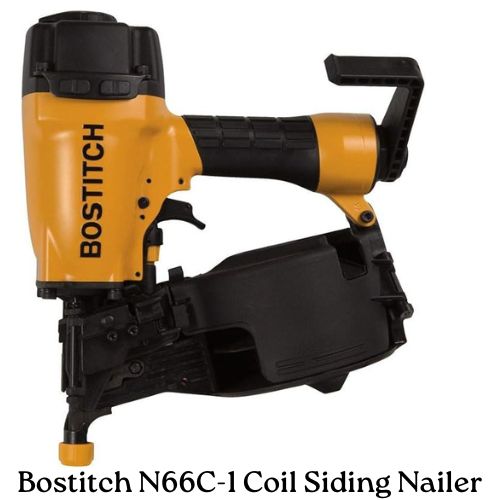
Key Features
- Compatible with nails ranging from 1-1/4 to 2-1/2 inches, with a diameter of .080-inch – .092-inch.
- Built with an aluminum material for strength body.
- Weight: 4.8 lbs (approx.)
- Weld and plastic inserted coil nails.
- Soft rubber foot.
- Adjustable exhaust that directs air away from the user.
Why You Should Choose It
The Bostitch N66C-1 is perfect for fiber cement siding projects. It has a large nail capacity. It comes with a soft rubber foot to prevent damage to softwood.
3. Makita AN613 Siding Coil Nailer
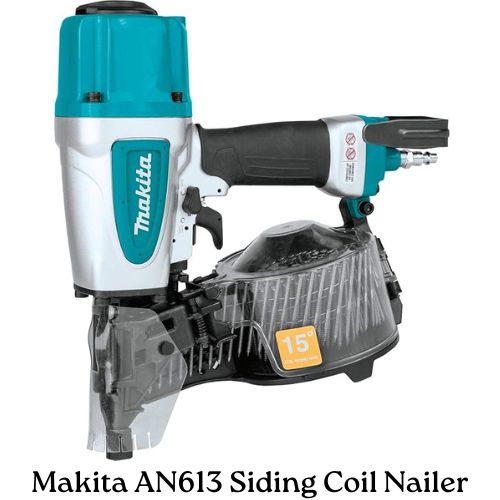
Key Features
- Drives nails of 2-1/2 inches.
- Drives 15º wire and plastic collated nails.
- 2 mode selector switch to select the contact or sequential trigger.
- Lightweight with aluminum material body.
- Multi directional exhaust
- Weight: 4.84 lbs (approx.)
Why You Should Choose It
This Makita AN613 nailer is well known for its solid construction and dependable performance on heavy duty siding tasks. Its ergonomic design reduces hand fatigue.
4. Freeman PCN65 Siding Nailer
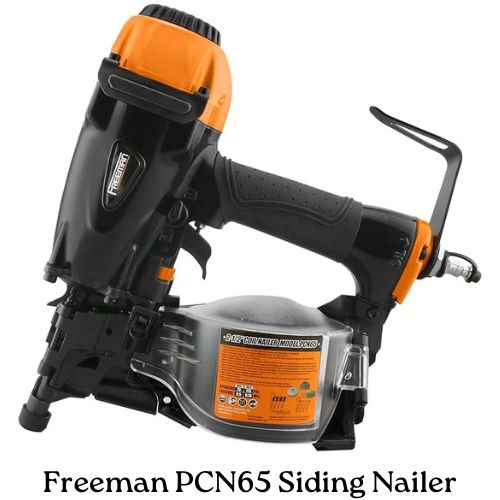
Key Features
- Compatible with 15 degree coil siding nails.
- Plastic collated ranges from 1-1/4″ to 2-1/2″.
- Wire collated ranges from 1-3/4″ to 2-1/2″ with a diameter of 0.09″ to 0.113″
- Die cast magnesium material.
- Weight: 5.5 lbs (approx.)
Why You Should Choose It
The Freeman model PCN65 is for budget friendly users. You will get reliability with minimal jamming.
5. Dewalt DW66C-1 Coil Siding Nailer
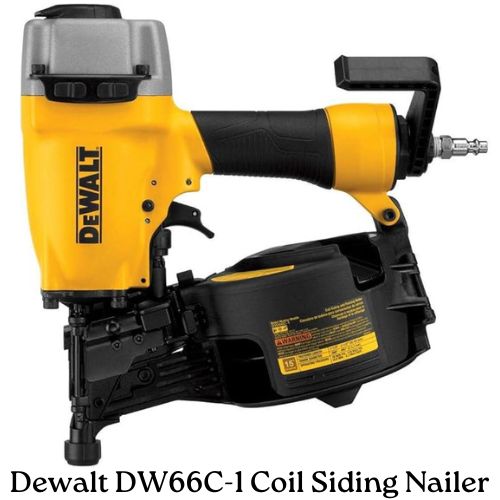
Key Features
- Drives nails from 1-1/4 to 2-1/2 inches.
- Built with a lightweight aluminum material.
- Tool free adjustable exhaust.
- Easy to use.
- Weight: 6.27 lbs (approx.)
Why You Should Choose It
The Dewalt DW66C-1 is user friendly, even for extended time of work.
Tips for Using a Nail Gun on Fiber Cement Siding
Follow these key tips to ensure a professional and durable finish:
Select the Right Nail Gun
Choose a coil siding nailer or a framing nailer suitable for fiber cement siding. These tools are built to handle tough materials.
Pick the Correct Nails
Use nails recommended by the siding manufacturer. These are usually hot dipped galvanized or stainless steel nails between 1-1/4 and 2-1/2 inches long.
Galvanized or stainless steel nails prevent rust. Avoid using nails that are too long, as they can damage the siding.
Adjust the Nail Depth
Set the nail gun’s depth so the nail head sits flush with the surface.
Test the depth setting on a scrap piece of siding before starting the project.
Follow Proper Nailing Placement
Place nails near the top edge of the siding, about 1 inch down. This allows the next panel to cover the nail heads.
Avoid nailing close to the edges to prevent cracking or splitting.
Find a Partner
Fiber cement siding can be heavy and difficult to manage alone. Having a partner helps with positioning and alignment.
Secure the Siding Properly
Use temporary fasteners or a siding gauge to hold the panel steady while nailing. This prevents shifting and ensures precise placement.
Maintain Your Nail Gun
Clean the nail gun’s air filter and nozzle, as fiber cement dust can cause clogs.
Regularly oil the tool as recommended to keep it in good working condition.
Prioritize Safety
Always wear eye protection and a dust mask, as cutting and nailing fiber cement produces fine silica dust.
Handle the nail gun carefully, keeping it pointed away from yourself.
Check Building Codes
Some areas have specific rules for installing fiber cement siding. Be sure to check the guidelines on nail type, and size.
Take Breaks to Avoid Fatigue
Installing siding can be exhausting. You can take breaks to prevent mistakes caused by tiredness.
Test the First Panel
Start by installing the first panel carefully. Check for proper alignment, nail placement, and depth.
Avoid Extreme Weather
Don’t install siding during harsh weather, like strong winds or heavy rain.
These conditions can make the job harder and affect the stability of the material.
Conclusion
Installing fiber cement siding doesn’t have to be overwhelming. With the right nail gun, you can achieve a high quality finish
Whether you choose a pneumatic nail gun, coil siding nailer, or framing nailer, make sure it’s suitable for your specific project.
FAQs
1. Can you use screws on fiber cement siding?
Ans: Yes, you can use screws for fiber cement siding in areas with strong winds, when attaching to metal frames, or for making repairs. However, in broader perepective nail gun is the effective tool.
2. Can you hammer a nail into the fiber cement siding?
Ans: Yes, it is possible to hammer a nail into fiber cement siding. But it’s not the best approach. The fiber cement material is dense and brittle which has a chance of cracking or splitting when nails are hammered directly. Nail guns are the better option than hammers in this case.
3. Can you nail into fiber cement siding?
Ans: Yes, nailing into fiber cement siding is possible, but it needs to be done carefully to prevent cracks or splits. For the best results, a pneumatic siding nailer is recommended as it ensures consistent depth and minimizes damage.
